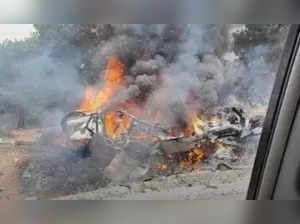
Rising Tensions: The Latest Strikes in Eastern Syria
Recent developments in eastern Syria have escalated fears of a wider conflict as air strikes, reported to have killed twelve pro-Iranian fighters, shake the already fragile region. This incident, according to the Syrian Observatory for Human Rights, highlights the ongoing power struggle influenced by regional players, primarily Iran and Israel.
 Escalating tensions in the Middle East
Escalating tensions in the Middle East
These air strikes targeted positions near the cities of Deir Ezzor and Boukamal, areas notorious for housing pro-Iranian militias. What remains curious, however, is the ambiguous origin of the strikes. While both Israel and the United States have histories of conducting operations against Iranian interests in Syria, no party has claimed responsibility for this attack. The uncertainty surrounding these events only adds to the volatility that characterizes this corner of the world.
A Commanding Loss
Among the fatalities was a senior commander of Iraq’s Hezbollah Brigades, known as Abu Haidar, who reportedly fell victim to a suspected Israeli drone strike near Damascus International Airport. This event underscores Israel’s relentless military campaign against what it perceives as threats along its borders.
“Israel has repeatedly emphasized it won’t allow Iran to expand its influence in Syria.”
This statement isn’t just rhetoric; recent weeks have witnessed an intensified bombing campaign targeting Hezbollah strongholds across Lebanon, which contributes to a growing fear of a regional war that could extend beyond its current confines. The strikes aren’t random; they’re surgical, targeting both leadership and supply routes with alarming precision.
The Broader Context
Iran’s military support for Syria has been a cornerstone of its strategy since the civil war erupted in 2011. As Syrian forces grapple with a multitude of internal conflicts, Iranian resources have poured in, positioning Tehran as a major player in the realm of military aid. This alignment is a critical factor in the ongoing tensions between Iran and its adversaries, particularly Israel, who are adamant about curtailing Iranian influence.
Moreover, the growing presence of American military assets in the region has complicated matters significantly. The United States has not shied away from acting against pro-Iranian groups, prompted by a geopolitical strategy aimed at weakening Iran’s foothold in both Syria and Iraq.
 Facets of conflict across various regions
Facets of conflict across various regions
Looking Ahead
As we analyze these developments, we must consider the implications for the future. How can regional stability be achieved amidst such unrelenting hostilities? With Israel reaffirming its stance against the Iranian presence in Syria and the United States continuing its counteractions, we are left contemplating the possible fallout from this cycle of violence. It seems apparent that without dialogue and more significant diplomatic efforts, the potential for escalation remains high.
The situation on the ground is fluid, with shifts occurring almost hourly. Each military operation further escalates tensions, raising questions about not only the immediate safety of those involved but also the broader implications for Middle Eastern geopolitics.
In conclusion, watching this situation unfold is unsettling but necessary for understanding the intricate balance of power in the region. As pro-Iranian fighters face intensified attacks, and as major players like Israel and the United States continue their operations, one can only hope for a swift return to dialogue rather than destruction. Only then can there be a chance for stability in this tumultuous part of the world.











